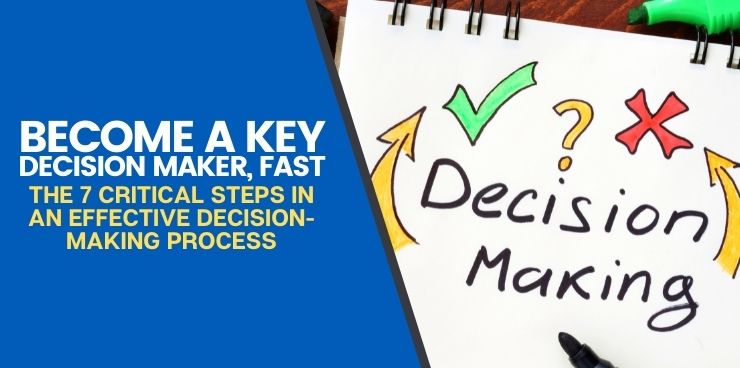Sometimes making decisions can be hard.
We’ve all been there: an important choice needs to be made, one that’s effective long-term while also affirming your core values. For business owners, establishing an effective decision-making process is critical to your success in the market.
But where do you start? Believe it or not, you’re already in the decision-making process simply by realizing that there’s a choice to be made.
Let’s look a little deeper into this whole idea. You’ll feel a lot better once you gather a bit more information (step 2). After all, when it comes to an effective decision-making process, information is the fuel that drives the engine of success!
What Are The Types of Decision Making?
Decision making is a huge topic, involving pretty much every moment of your day and that of your customers. To make things easier, let’s break this concept into a few smaller categories. You could think of the process as one of these decision-making models:
- Everyday (“routine”) decisions.
- Narrow (“limited”) decisions.
- Broad (“extensive”) decisions.
Everyday decisions are made almost automatically, sometimes impulsively, and without much conscious thought. Your job as a business owner is ensuring they’re made deliberately, while also keeping them simple and obvious for your clients.
Identify the brand decision-maker among your customers and create a scenario in which your product is the obvious choice. Building a relationship of trust and familiarity will ensure that they come back to you again and again over the long term.
At the same time, make sure that you’re being deliberate in your everyday decisions as well. If your business has always bought from the same provider or done things a certain way, ask why? Make sure you re-evaluate these decisions regularly.
Narrow choices require little effort in the decision-making process as they are generally just simple investments. There’s not a lot of homework necessary for these decisions, and they’re often based more on emotion than information.
Ordering at a familiar restaurant is a good example. Due to the restaurant’s brand positioning, you feel comfortable with their product list (menu items). There isn’t much risk involved, so your decision-making process in this area will be simple and relatively quick.
Chances are that you have already began making your decision on your way to the restaurant! Why? Because eating there is an everyday, routine choice. That’s how you want your business to feel to your clients.
Broad decisions take a bit more time and involve more risk. Maybe you’re considering investing in a new location or maybe a client is considering purchasing from you for the first time. Either way, the decision-making process in this category requires greater investment of time and money.
You need to do your homework to make sure this decision is the best for you. You also need to present yourself in a way that makes your clients feel confident in choosing you.
The risks and benefits of each type of decision-making can vary depending on the situation, but the process is always important. Let’s look at why good decision-making is important to your business.
Why Is Good Decision-making Important?
Having an effective decision-making process in place is critical to your long-term success. Why is that? Because this process is the bedrock of everything your company stands for and will determine the path it takes. Your mission vision values and key goals can only be reached by making sound decisions.
Will this purchase further your company’s mission? Does that investment or new hire reflect your company’s values? Have you created a space in which customers feel valued and confident buying from you?
The answers to all of these questions are based on the decision-making process you‘ve chosen to implement. Let’s consider the steps of an effective decision-making process.
The Steps of the Decision-making Process
The steps of an effective decision-making process are based on seven deliberate actions. Follow these steps when faced with important decisions and you’ll see real results, both in business and in life.
Specify your decision
This step is more important than you may at first think. It involves realizing that a decision must be made and then considering the ramifications. For example, let’s say profits are stagnant in an otherwise healthy economy.
Should you consider a new marketing plan? How about a new product line? Or maybe you need to improve production?
Step one in the decision-making process is identifying your decision in the first place. Once you know what you’re deciding, you’re ready for step two.
Gather more information
Step two is where you collect the data that will inform all of the following steps. The information you need to make your decision can be both external and internal.
External information would be data like market forecasts, consumer patterns, or competitor performance.
Internal information could include productivity reports, self-audits, or in-house research and development data. If you’re going to improve profits and beat that competition, you have to know what’s really going on.
As G.I. Joe once said, knowledge is half the battle!
Identify your options
Okay, you’ve identified your core decision and gathered as much information as you can on the idea. What’s next? Make a list.
Based on what you’ve discovered through your research, begin to identify possible solutions or choices, also known as “alternatives”. Lay out a few different ways that you could solve your problem. Seeing them in front of you will ensure a smoother decision-making process.
Using our scenario above, let’s say that you’ve decided to invest capital to increase sales. Possible alternatives might include investing in more efficient production lines, updating marketing strategies or expanding your market presence (new location).
Follow the data
In this step, you’ll want to take the information gathered in step two and apply it to each of your alternatives. Ask yourself which choice has the highest potential to succeed at the goal identified in step one. Which solution makes the most logical sense? Which alternative most closely aligns with your company’s values and mission?
Begin to list your alternatives by priority based on the evidence you’ve collected. Your priorities will depend on the values and needs you laid out at the very beginning.
Go with the best
At this point in the decision-making process you must make a choice. Think of it as making a decision within a decision! Here you will make cuts like a sports captain, valuing all of your options but choosing only the very best.
Don’t be concerned if you can’t seem to decide on only one alternative. Sometimes more than one can be combined into a new, better alternative. Using our example, maybe you decide that you need a new location AND an updated marketing strategy highlighting your growth?
What better way to catch customer attention, inspire new leads and create market buzz?
Take necessary action
It’s one thing to sit at the drawing board looking at graphs and charts. It’s another thing to take the necessary action. This step is where the rubber hits the road; it’s going to require some discipline and vision to see it implemented. Thankfully, you’ve followed all the steps and can now act with confidence and focus.
You know where you’re headed and why. You’re equipped with the necessary information and have chartered your course.
You’ve got this.
Decision Evaluation
Now it’s time to evaluate the fruits of your decision. Did your choice solve the original issue? Consider the outcome and ask yourself if there’s something more (or less) that could be done. If your original issue isn’t quite resolved, maybe you need to repeat a step.
Perhaps you should reconsider your answer to step one, or maybe you just need additional information? Then again, maybe everything turned out perfect.
Either way, these steps can be used as guideposts whenever you need them to help you make the best decisions.
What is the most important step in the Decision-making Process?
The most important step in the decision-making process is step one: specifying your decision. Your journey will fail if you don’t know the destination. Once you’ve identified your decision precisely, all the other steps will fall into place.
We can help you make your best business decisions
When it comes to making the best decisions for your business, we can help you find the confidence you need. At Selling Revolution, we help businesses like yours take these steps to success everyday.
We understand that every business faces decisions unique to their situation. That’s why we’re prepared to help you fully customize your choice generator for your business needs.
Book a call with Selling Revolution today and let’s get this ball rolling!




